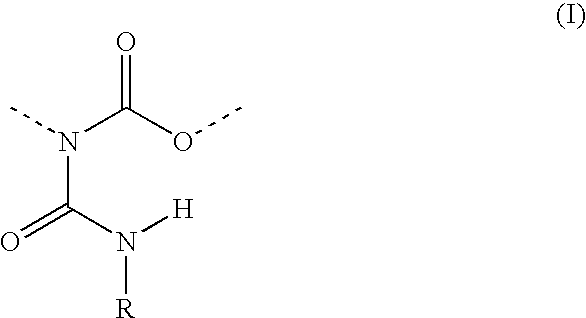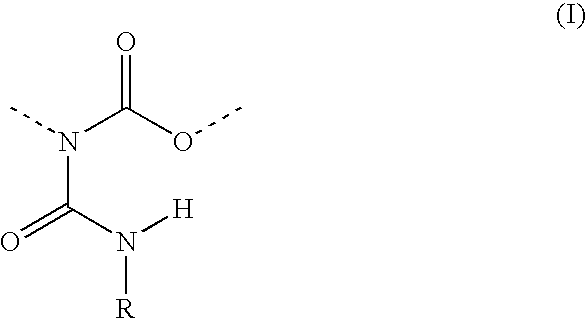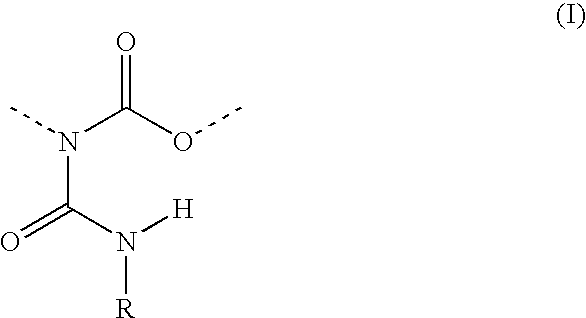Allophanate-containing modified polyurethanes
a technology of modified polyurethanes and allophanates, which is applied in the field of allophanate-containing modified polyurethanes to achieve the effect of lowering the viscosity of compositions
- Summary
- Abstract
- Description
- Claims
- Application Information
AI Technical Summary
Benefits of technology
Problems solved by technology
Method used
Image
Examples
example 1
Allophanate-Containing Binder According to the Invention
[0100] 175.77 g of hexamethylene diisocyanate (Desmodur® H, Bayer MaterialScience, Leverkusen, Del.) and 50 mg of phenothiazine were initially introduced into a 500 ml, four-necked glass flask equipped with a reflux condenser, heatable oil bath, mechanical stirrer, air throughput, internal thermometer and dropping funnel and were heated to 70° C. 25 mg of dibutyltin dilaurate (Desmorapid Z, Bayer MaterialScience, Leverkusen) were added and 203.79 g of hydroxypropyl acrylate were added dropwise such that the temperature did not exceed 80° C. The mixture was subsequently stirred until the theoretical NCO content of 5.77% was reached. 119.61 g of hexyl isocyanate were then added, the temperature was increased to 80° C. and 0.75 g of choline 2-ethylhexanoate was metered in slowly over 6 hours. After somewhat more than half the time, a significant exothermicity was recorded, which necessitated cooling of the mixture. Metering was c...
example 2
Allophanate-Containing Binder According to the Invention
[0101] 185.57 g of hexamethylene diisocyanate (Desmodur® H, Bayer MaterialScience, Leverkusen, Del.) and 25 mg of phenothiazine were initially introduced into a 500 ml, four-necked glass flask equipped with a reflux condenser, heatable oil bath, mechanical stirrer, air throughput, internal thermometer and dropping funnel and were heated to 70° C. 25 mg of dibutyltin dilaurate (Desmorapid Z, Bayer MaterialScience, Leverkusen) were added and 215.15 g of hydroxypropyl acrylate were added dropwise such that the temperature did not exceed 80° C. The mixture was subsequently stirred until the theoretical NCO content of 5.77% was reached. 98.48 g of butyl isocyanate (Lanxess, Leverkusen, content of hydrolyzable chlorine approx. 100 ppm) were then added, the temperature was increased to 80° C. and 0.75 g of choline 2-ethylhexanoate was metered in slowly over 6 hours. After somewhat more than half the time, a significant exothermicity ...
example 3
Allophanate-Containing Binder According to the Invention
[0103] 148.62 g of hexamethylene diisocyanate (Desmodur® H, Bayer MaterialScience, Leverkusen, Del.) and 40 mg of phenothiazine were initially introduced into a 500 ml, four-necked glass flask equipped with a reflux condenser, heatable oil bath, mechanical stirrer, air throughput, internal thermometer and dropping funnel and were heated to 70° C. 20 mg of dibutyltin dilaurate (Desmorapid Z, Bayer MaterialScience, Leverkusen, Del.) were added and 160.82 g of hydroxypropyl acrylate were added dropwise such that the temperature did not exceed 80° C. The mixture was subsequently stirred until the theoretical NCO content of 7.18% was reached. 89.90 g of hexyl isocyanate were then added, the temperature was increased to 80° C. and 0.60 g of choline 2-ethylhexanoate was metered in slowly over 6 hours. After somewhat more than half the time, a significant exothermicity was recorded, which necessitated cooling of the mixture. Metering ...
PUM
| Property | Measurement | Unit |
|---|---|---|
| Pressure | aaaaa | aaaaa |
| Pressure | aaaaa | aaaaa |
| Pressure | aaaaa | aaaaa |
Abstract
Description
Claims
Application Information
 Login to View More
Login to View More - R&D
- Intellectual Property
- Life Sciences
- Materials
- Tech Scout
- Unparalleled Data Quality
- Higher Quality Content
- 60% Fewer Hallucinations
Browse by: Latest US Patents, China's latest patents, Technical Efficacy Thesaurus, Application Domain, Technology Topic, Popular Technical Reports.
© 2025 PatSnap. All rights reserved.Legal|Privacy policy|Modern Slavery Act Transparency Statement|Sitemap|About US| Contact US: help@patsnap.com



